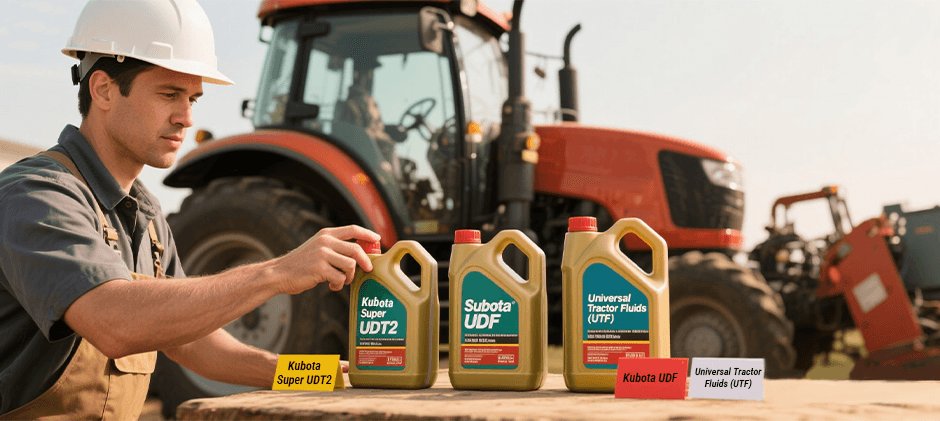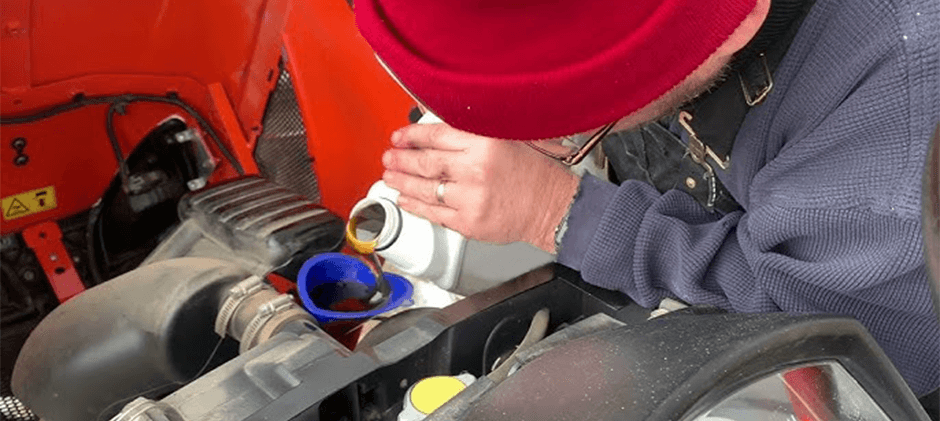Hydraulic fluid is crucial to the hydraulic system of Kubota tractors. It ensures lubrication and efficient power transmission. Using the wrong hydraulic fluid can lead to decreased performance, premature wear, and even catastrophic failure of critical components. To address the confusion surrounding hydraulic fluid selection, this article will explore the different types of hydraulic fluid suitable for Kubota tractors, as well as how to select and maintain hydraulic fluid, to help you make the right choice.
Key Takeaways
- The Kubota Standard: Kubota’s primary recommendations are Kubota Super UDT2 (a premium, full-synthetic fluid) or Kubota UDF (a conventional universal fluid). Your choice depends on your climate and performance needs.
- Equivalents Are Acceptable: High-quality aftermarket fluids that explicitly state they meet Kubota’s UDT or Super UDT2 specifications are a safe and cost-effective alternative.
- The Wrong Fluid Damages Parts: Moreover, using the wrong fluid can damage seals, glaze wet brake discs, cause transmission clutch slippage, and starve the hydraulic pump of proper lubrication. As a result, this can lead to costly failures of the essential Kubota tractor parts you depend on.
- Always Check Your Manual: The ultimate authority is your tractor’s operator’s manual. It will specify the exact fluid type required for your model.
Why Hydraulic Fluid Matters?
Kubota tractor hydraulic fluid isn’t just “fluid” —it’s a precision-engineered liquid that performs four key functions at once, making it essential to your tractor’s reliability and performance.
- Power Transmission: The fluid transfers hydraulic pressure from the pump to components like your loader, 3-point hitch, and steering system. Its resistance to compression allows your Kubota to lift and move heavy loads with ease.
- Lubrication: In Kubota’s shared sump design, hydraulic fluid also lubricates the transmission. It protects gears, bearings, and clutch plates from metal-on-metal wear, extending the life of critical drivetrain parts.
- Heat Dissipation: Hydraulic systems run hot. The fluid absorbs heat from key components and returns it to the sump for cooling, helping to prevent damage from overheating.
- Contamination Control & Protection: The fluid suspends debris until it’s filtered out, and additives fight rust and corrosion inside the system. This keeps internal Kubota parts cleaner and lasts longer.
Using non-Kubota-approved hydraulic fluid compromises all four of these functions, risking damage to your tractor’s hydraulics, transmission, and more.
Types of Hydraulic Fluids for Kubota Tractors
When selecting hydraulic fluids for your Kubota tractor, always consult your manual and choose a product that meets the recommended specifications. Below, we outline the top hydraulic fluid options compatible with Kubota equipment available on the market.
The OEM Standards
Kubota has two primary fluid formulations that they recommend for their tractors. Understanding the difference is key to choosing correctly.
- Kubota Super UDT2 (Universal Dynamic Tractor Fluid): This is the premium, top-tier option. It is a full-synthetic fluid designed for superior performance across an extremely wide range of temperatures. It flows better in freezing winter conditions and provides better protection under extreme summer heat. It is the recommended choice for newer, high-performance tractors, especially those with hydrostatic transmissions (HST).
- Kubota UDF (Universal Draulic Fluid): This is Kubota’s standard, high-quality conventional (mineral-based) fluid. It provides excellent protection and performance for a wide variety of Kubota models and is suitable for most general-use applications in moderate climates.
Aftermarket Universal Tractor Fluids (UTF)
Many reputable oil companies produce high-quality Universal Tractor Fluids (UTF), also known as Tractor Hydraulic Fluids (THF), that are engineered to be direct equivalents to OEM fluids.
The critical factor here is the specification. A quality aftermarket fluid will explicitly state on its label that it “Meets or Exceeds Kubota UDT” or “Is Recommended for Systems Requiring Kubota Super UDT2.” This means the manufacturer guarantees its performance and compatibility. These fluids are often more affordable than the OEM-branded product while providing the same level of protection.
| Fluid Type | Base | Best For | Key Advantage |
|---|---|---|---|
| Super UDT2 | Synthetic | High-performance tractors, HST models, and extreme hot/cold climates | Superior temperature stability, longer life, smoother operation |
| UDF | Conventional | General-purpose use, gear-drive tractors, moderate climates | Excellent all-around protection, cost-effective |
| Equivalent UTF | Conventional or Synthetic | Owners seeking value without sacrificing quality | Can meet OEM specs at a lower price point |
How to Choose the Right Hydraulic Fluid?
With the types defined, making your choice comes down to a simple, three-step process.
Step 1: Consult Your Operator’s Manual (The Golden Rule)
Before you do anything else, find your tractor’s operator’s manual. It is the single most reliable source of information. It will have a “Fluids and Lubricants” section that tells you exactly what specification your machine requires. Some dipsticks or filler caps may also have the required fluid type stamped on them.
Step 2: Evaluate Your Climate and Workload
Do you operate in freezing winters or scorching summers? If you face extreme temperatures, the synthetic Super UDT2 (or a synthetic equivalent) is a wise investment. It will allow for easier starts and smoother hydraulic operation on cold mornings and will resist breaking down under heavy, high-heat work in the summer.
Is your work light-duty in a moderate climate? The conventional UDF or a high-quality UDF-equivalent will serve you perfectly well and save you some money.
Step 3: Consider Your Transmission Type
While not a strict rule, tractors with a hydrostatic transmission (HST) benefit greatly from the superior lubricating and cooling properties of a synthetic fluid like Super UDT2. The HST unit generates significant heat and is very sensitive to fluid quality. Giving it the best fluid possible is cheap insurance for a very expensive component.
How to Change Hydraulic Fluid in a Kubota Tractor?
Performing a fluid and filter change is one of the most important maintenance tasks you can do.
- Gather Your Supplies: You’ll need the correct type and amount of new hydraulic fluid, a new hydraulic filter, a drain pan, and the necessary wrenches.
- Warm Up the Tractor: Run the tractor for 5-10 minutes to warm the fluid. Warm fluid drains faster and carries more contaminants out with it.
- Position and Safety: Park the tractor on a level surface, engage the parking brake, and turn off the engine.
- Drain the Fluid: Locate the hydraulic drain plug(s) under the tractor (there may be more than one). Place your drain pan, remove the plugs, and let the old fluid drain completely.
- Replace the Hydraulic Filter: This is a critical step. A new filter is essential to protect your system. Unscrew the old filter, apply a thin film of new oil to the gasket of the new one, and screw it on until it’s hand-tight, plus another half-turn.
- Refill with New Fluid: Clean the drain plugs and reinstall them. Slowly pour the new fluid into the hydraulic fill port until it reaches the “Full” mark on the dipstick. Do not overfill.
- Check Your Work: First, start the engine and let it run for a minute. Then, operate the hydraulics (lift the loader, etc.) to circulate the new fluid. Next, shut down the engine and wait a few minutes. After that, re-check the fluid level and top off as needed. Finally, check for any leaks around the drain plugs and filter.
This is a great time to inspect your hydraulic system. Suppose you notice cracked or weeping hydraulic hoses or leaking seals. In that case, it’s the perfect opportunity to order those replacement Kubota tractor parts and fix small problems before they become big ones. At FridayParts, we offer a wide range of high-quality filters, hoses, and seals to help you complete the job correctly.
Tips for Hydraulic Fluid Maintenance in Kubota Tractors
- Check the Level Regularly: Make checking the hydraulic fluid dipstick part of your pre-operation routine.
- Inspect the Fluid Condition: Pull the dipstick and look at the fluid. It should be clear and amber-colored. If it looks milky, you have water contamination. If it’s dark and smells burnt, it’s overheating.
- Keep it Clean: Never open the hydraulic system in a dirty, dusty environment. Wipe down the filler cap area before opening it to prevent dirt from falling in.
- Stick to the Schedule: Change your fluid and filter according to the interval specified in your manual (typically every 200 hours, but check your specific model).
Summary
Choosing the correct type—whether it’s Kubota’s OEM Super UDT2, standard UDF, or a high-quality aftermarket equivalent—can significantly impact your machine’s performance and longevity. Always consult your operator’s manual, consider your climate and transmission type, and follow proper maintenance procedures. At FridayParts, we offer durable Kubota aftermarket parts so you can purchase replacement parts when changing hydraulic fluid to ensure your equipment runs efficiently.


